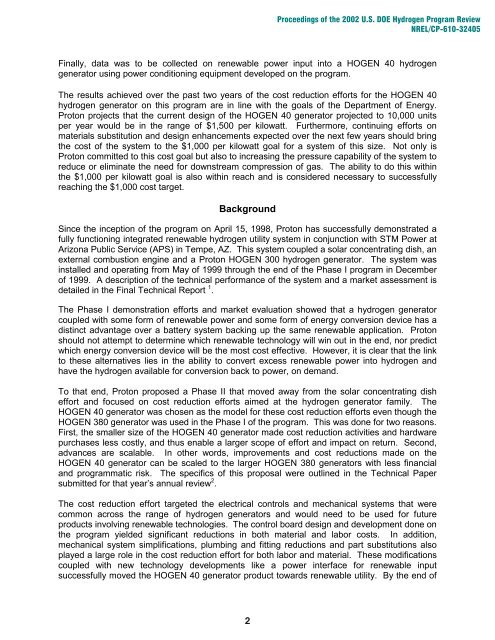Hydrogen Production Through Electrolysis - NREL
Hydrogen Production Through Electrolysis - NREL
Hydrogen Production Through Electrolysis - NREL
Create successful ePaper yourself
Turn your PDF publications into a flip-book with our unique Google optimized e-Paper software.
Proceedings of the 2002 U.S. DOE <strong>Hydrogen</strong> Program Review<br />
<strong>NREL</strong>/CP-610-32405<br />
Finally, data was to be collected on renewable power input into a HOGEN 40 hydrogen<br />
generator using power conditioning equipment developed on the program.<br />
The results achieved over the past two years of the cost reduction efforts for the HOGEN 40<br />
hydrogen generator on this program are in line with the goals of the Department of Energy.<br />
Proton projects that the current design of the HOGEN 40 generator projected to 10,000 units<br />
per year would be in the range of $1,500 per kilowatt. Furthermore, continuing efforts on<br />
materials substitution and design enhancements expected over the next few years should bring<br />
the cost of the system to the $1,000 per kilowatt goal for a system of this size. Not only is<br />
Proton committed to this cost goal but also to increasing the pressure capability of the system to<br />
reduce or eliminate the need for downstream compression of gas. The ability to do this within<br />
the $1,000 per kilowatt goal is also within reach and is considered necessary to successfully<br />
reaching the $1,000 cost target.<br />
Background<br />
Since the inception of the program on April 15, 1998, Proton has successfully demonstrated a<br />
fully functioning integrated renewable hydrogen utility system in conjunction with STM Power at<br />
Arizona Public Service (APS) in Tempe, AZ. This system coupled a solar concentrating dish, an<br />
external combustion engine and a Proton HOGEN 300 hydrogen generator. The system was<br />
installed and operating from May of 1999 through the end of the Phase I program in December<br />
of 1999. A description of the technical performance of the system and a market assessment is<br />
detailed in the Final Technical Report 1 .<br />
The Phase I demonstration efforts and market evaluation showed that a hydrogen generator<br />
coupled with some form of renewable power and some form of energy conversion device has a<br />
distinct advantage over a battery system backing up the same renewable application. Proton<br />
should not attempt to determine which renewable technology will win out in the end, nor predict<br />
which energy conversion device will be the most cost effective. However, it is clear that the link<br />
to these alternatives lies in the ability to convert excess renewable power into hydrogen and<br />
have the hydrogen available for conversion back to power, on demand.<br />
To that end, Proton proposed a Phase II that moved away from the solar concentrating dish<br />
effort and focused on cost reduction efforts aimed at the hydrogen generator family. The<br />
HOGEN 40 generator was chosen as the model for these cost reduction efforts even though the<br />
HOGEN 380 generator was used in the Phase I of the program. This was done for two reasons.<br />
First, the smaller size of the HOGEN 40 generator made cost reduction activities and hardware<br />
purchases less costly, and thus enable a larger scope of effort and impact on return. Second,<br />
advances are scalable. In other words, improvements and cost reductions made on the<br />
HOGEN 40 generator can be scaled to the larger HOGEN 380 generators with less financial<br />
and programmatic risk. The specifics of this proposal were outlined in the Technical Paper<br />
submitted for that year’s annual review 2 .<br />
The cost reduction effort targeted the electrical controls and mechanical systems that were<br />
common across the range of hydrogen generators and would need to be used for future<br />
products involving renewable technologies. The control board design and development done on<br />
the program yielded significant reductions in both material and labor costs. In addition,<br />
mechanical system simplifications, plumbing and fitting reductions and part substitutions also<br />
played a large role in the cost reduction effort for both labor and material. These modifications<br />
coupled with new technology developments like a power interface for renewable input<br />
successfully moved the HOGEN 40 generator product towards renewable utility. By the end of<br />
2

















